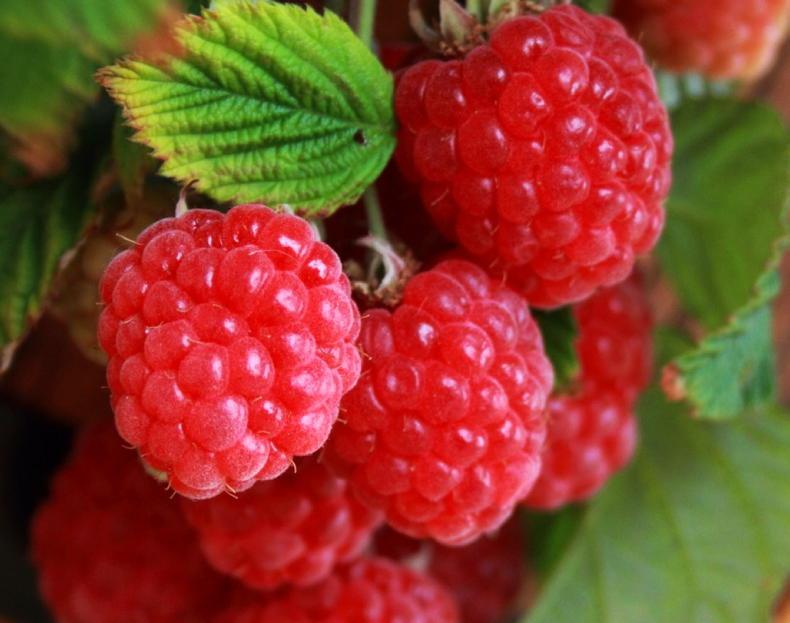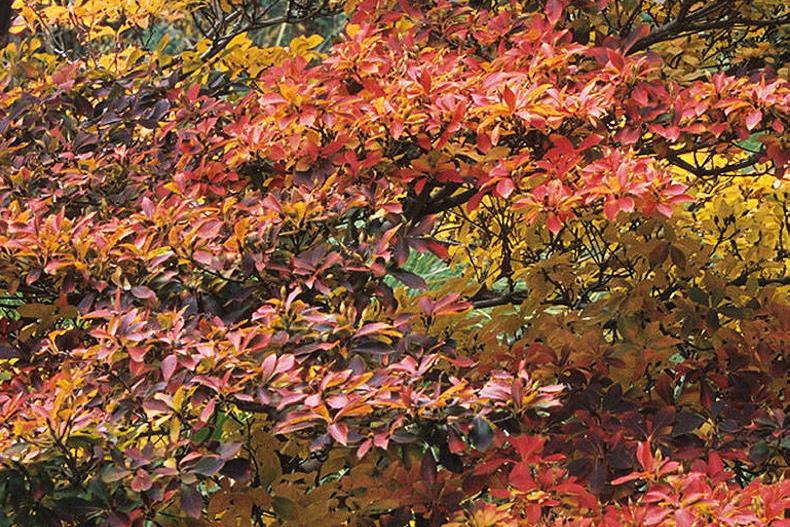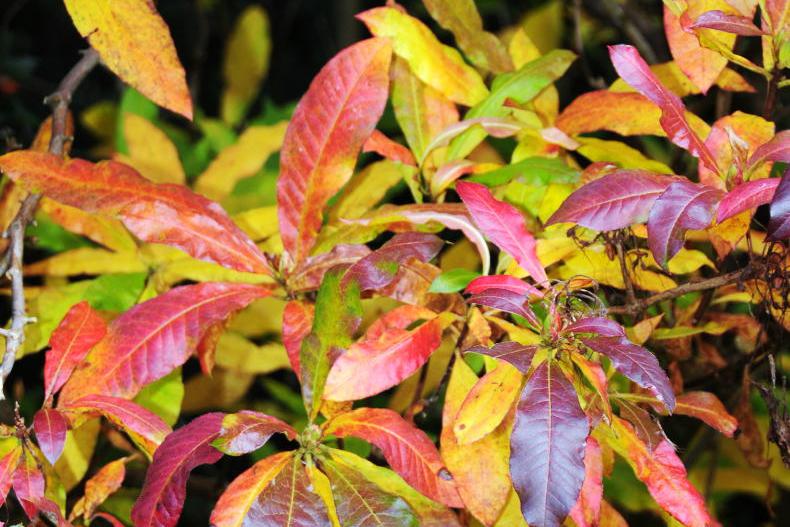Although it is better known by its correct botanical name of enkianthus, redvein is a good name as it relates directly to a feature of the plant, namely, the tiny red veins that appear on the nodding flowers. Part of the rhododendron/heather family, the enkianthus flowers are small and bell-shaped, carried in masses on slender, dangling flower stems. Each flower has its own flower stem and these are carried in a cluster of flowers. Sometimes the flower stems are of different length, which has the flowers appear to cascade down the plant, but sometimes they are the same length which gives a fringed flower effect.
The branches are held in almost-horizontal fashion, in attractive tiers. The main species grown here is Enkianthus campanulatus, native to Japan, the second part of the name referring to the bell-shaped flowers. This plant can make a large shrub, to three metres tall and wide, which is why it suits a country garden very well. At a glance, when in leaf or leafless, it looks very like a deciduous azalea in shape and general structure.
The flower colour is generally a light shade of cream or soft yellow with clearly prominent veining in red
It grows to full size by sending up upright shoots which later spread outwards at the top forming tiers of foliage and flowers. Flowering is in late spring and early summer and lasts well for several weeks, though it is usually necessary to approach the plant to actually see the delightful clusters of bell-flowers.
The flowering is very pretty, and very distinctive. The flower colour is generally a light shade of cream or soft yellow with clearly prominent veining in red. ‘Pagoda’ is a popular variety that is widely available and typical of many specimens grown in gardens. It carries masses of drooping flowers, pale cream colour, marked with red veins. Its name gives a clue as to the shape and character of this variety. It has excellent autumn, which displays in bright red, orange and yellow. There is another kind, Enkianthus cernuus var. rubens, sometimes seen, with raspberry red flowers, still not a beacon of colour, but richer than the main kind. This is a different species, smaller-growing, though harder to find.
Hardy
Enkinathus is hardy and long-lived. It is an ideal shrub to start off on the edge of woodland or backed by a hedge more than three metres away. It likes some shelter, being a woodland and scrub-area shrub in Japan. It should be given good deep, well-drained soil that does not dry out too much in summer. Like rhododendron, it likes acidic soil but it is not as demanding as most rhododendrons and can cope fine with neutral soil. On limy soil, it would be necessary to dig in lots of leaf-mould or garden compost to an area of four square metres and to top this up with a mulch of leaf-mould or similar each spring or every second year.
While the plant is at its prettiest in early summer with the new soft-green leaves and pale-coloured bells, it is also excellent in late autumn when the leaves turn to shades of red and yellow. This takes place over a long time and it is often one of the latest shrubs to remain in autumn colour. The leaves form flat sheets over the horizontal, gently tiered branches. For its various charms, ease of growth, and great longevity, this is a shrub worth seeking out and planting in the coming months.
Plant raspberries
The traditional planting season for fruit trees and bushes of all kinds has just begun and so it is a good time to plant raspberries. Raspberries are a delicious fruit to eat fresh or for cooking. There are two kinds: summer fruiting kinds and autumn fruiting. The summer kind fruit on the shoots made the previous year and the autumn kind fruit in late summer and early autumn on shoots made the same year. Either kind can be planted right away or in the coming months.

Raspberries.
Planted now, the canes get nicely established before spring and grow away actively next year. The plants can be planted in a row, or against a wall or fence, about 50cm apart with some posts and three wires to hold the canes of summer kinds in place. The autumn kind are much shorter and generally do not need support. Plant in good soil in sunshine for best cropping, without root competition from existing shrubs or trees.
Fruit, vegetables and herbs
Dig over vegetable ground, removing old crops, and chopping them up for the compost heap. Store vegetables that can be over-wintered in a pit or cool shed. Control weeds over areas of ground that will be dug over later. Spread compost before digging it in. Plant new fruit trees and bushes.
Lawns
Lawn mosskiller can be used to reduce lawn moss. Moss will grow strongly from now until early May and can build up to severe levels in that time. Occasional mowing in winter is a good idea if the soil is not too wet. Grass tends to grow a little over winter and an occasional mowing will keep it neat.
Trees, shrubs and roses
Planting of bare-root deciduous trees, hedging and shrubs can continue during dry weather. Don’t plant into very wet ground or into planting holes that fill with water, because wet conditions cause the roots to rot. All kinds of pot-grown trees and shrubs can also be planted now as well as bare-root.
Flowers
Lift dahlias, begonias and gladiolus in frosty localities inland to prevent damage, or cover them with soil or compost in milder areas. Spring bulbs should be in the ground but should be planted if not. Tulips and alliums can be planted late without set-back. Plant bedding plants for spring colour.
Greenhouse and house plants
Remove all debris and dead plants and ventilate occasionally. Water very little and do not splash water about in order to reduce the risk of grey mould disease. Set up a greenhouse frost protection heater to protect tender plants during occasional spells of hard frost.
Read more
Gerry Daly: monster trees
In the garden with Gerry Daly: slinky shapes
Although it is better known by its correct botanical name of enkianthus, redvein is a good name as it relates directly to a feature of the plant, namely, the tiny red veins that appear on the nodding flowers. Part of the rhododendron/heather family, the enkianthus flowers are small and bell-shaped, carried in masses on slender, dangling flower stems. Each flower has its own flower stem and these are carried in a cluster of flowers. Sometimes the flower stems are of different length, which has the flowers appear to cascade down the plant, but sometimes they are the same length which gives a fringed flower effect.
The branches are held in almost-horizontal fashion, in attractive tiers. The main species grown here is Enkianthus campanulatus, native to Japan, the second part of the name referring to the bell-shaped flowers. This plant can make a large shrub, to three metres tall and wide, which is why it suits a country garden very well. At a glance, when in leaf or leafless, it looks very like a deciduous azalea in shape and general structure.
The flower colour is generally a light shade of cream or soft yellow with clearly prominent veining in red
It grows to full size by sending up upright shoots which later spread outwards at the top forming tiers of foliage and flowers. Flowering is in late spring and early summer and lasts well for several weeks, though it is usually necessary to approach the plant to actually see the delightful clusters of bell-flowers.
The flowering is very pretty, and very distinctive. The flower colour is generally a light shade of cream or soft yellow with clearly prominent veining in red. ‘Pagoda’ is a popular variety that is widely available and typical of many specimens grown in gardens. It carries masses of drooping flowers, pale cream colour, marked with red veins. Its name gives a clue as to the shape and character of this variety. It has excellent autumn, which displays in bright red, orange and yellow. There is another kind, Enkianthus cernuus var. rubens, sometimes seen, with raspberry red flowers, still not a beacon of colour, but richer than the main kind. This is a different species, smaller-growing, though harder to find.
Hardy
Enkinathus is hardy and long-lived. It is an ideal shrub to start off on the edge of woodland or backed by a hedge more than three metres away. It likes some shelter, being a woodland and scrub-area shrub in Japan. It should be given good deep, well-drained soil that does not dry out too much in summer. Like rhododendron, it likes acidic soil but it is not as demanding as most rhododendrons and can cope fine with neutral soil. On limy soil, it would be necessary to dig in lots of leaf-mould or garden compost to an area of four square metres and to top this up with a mulch of leaf-mould or similar each spring or every second year.
While the plant is at its prettiest in early summer with the new soft-green leaves and pale-coloured bells, it is also excellent in late autumn when the leaves turn to shades of red and yellow. This takes place over a long time and it is often one of the latest shrubs to remain in autumn colour. The leaves form flat sheets over the horizontal, gently tiered branches. For its various charms, ease of growth, and great longevity, this is a shrub worth seeking out and planting in the coming months.
Plant raspberries
The traditional planting season for fruit trees and bushes of all kinds has just begun and so it is a good time to plant raspberries. Raspberries are a delicious fruit to eat fresh or for cooking. There are two kinds: summer fruiting kinds and autumn fruiting. The summer kind fruit on the shoots made the previous year and the autumn kind fruit in late summer and early autumn on shoots made the same year. Either kind can be planted right away or in the coming months.

Raspberries.
Planted now, the canes get nicely established before spring and grow away actively next year. The plants can be planted in a row, or against a wall or fence, about 50cm apart with some posts and three wires to hold the canes of summer kinds in place. The autumn kind are much shorter and generally do not need support. Plant in good soil in sunshine for best cropping, without root competition from existing shrubs or trees.
Fruit, vegetables and herbs
Dig over vegetable ground, removing old crops, and chopping them up for the compost heap. Store vegetables that can be over-wintered in a pit or cool shed. Control weeds over areas of ground that will be dug over later. Spread compost before digging it in. Plant new fruit trees and bushes.
Lawns
Lawn mosskiller can be used to reduce lawn moss. Moss will grow strongly from now until early May and can build up to severe levels in that time. Occasional mowing in winter is a good idea if the soil is not too wet. Grass tends to grow a little over winter and an occasional mowing will keep it neat.
Trees, shrubs and roses
Planting of bare-root deciduous trees, hedging and shrubs can continue during dry weather. Don’t plant into very wet ground or into planting holes that fill with water, because wet conditions cause the roots to rot. All kinds of pot-grown trees and shrubs can also be planted now as well as bare-root.
Flowers
Lift dahlias, begonias and gladiolus in frosty localities inland to prevent damage, or cover them with soil or compost in milder areas. Spring bulbs should be in the ground but should be planted if not. Tulips and alliums can be planted late without set-back. Plant bedding plants for spring colour.
Greenhouse and house plants
Remove all debris and dead plants and ventilate occasionally. Water very little and do not splash water about in order to reduce the risk of grey mould disease. Set up a greenhouse frost protection heater to protect tender plants during occasional spells of hard frost.
Read more
Gerry Daly: monster trees
In the garden with Gerry Daly: slinky shapes











SHARING OPTIONS